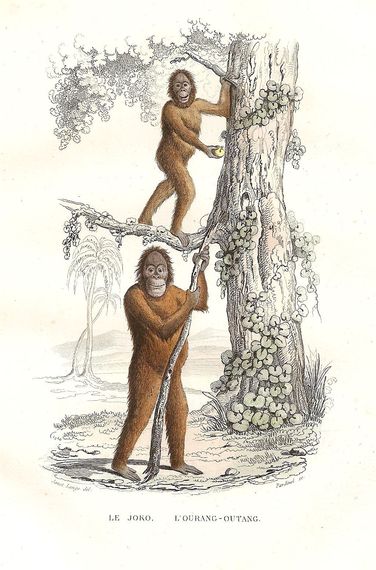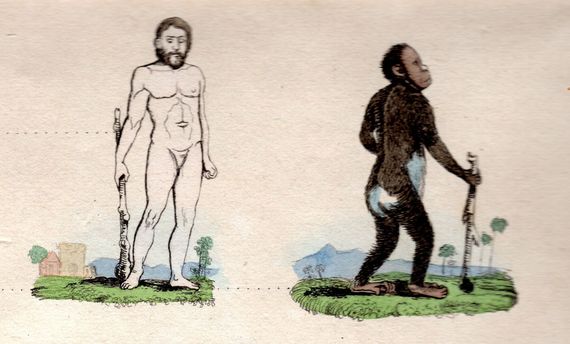As a historian of human-animal relations, I often find illustrations, which reveal assumptions beneath the threshold of consciousness, not only livelier but also more illuminating than texts. I search in flea markets for pictures taken from old natural history books. Our conceptualization of animals changes so profoundly that, after a century or so has passed that depictions of animals such as elephants or sloths generally look like creatures of fantasy. One of the best examples of this is the depictions of apes before Darwin.
It is odd how triumphalist rhetoric pervades campaigns against anthropocentrism. Every perceived strike against human exceptionalism, for example the Copernican universe or Darwin's Theory of Evolution, is presented as one more step in human progress. This is expected to lead to a vaguely delineated utopia, where human beings, inspired by their kinship with the cosmos, will benevolently manage and control the world.
Accordingly, Jane Goodall's "revolutionary" discovery that animals, specifically chimpanzees, use tools is considered a major blow to the prevailing idea of human uniqueness. Maybe it was one in the latter twentieth century when she made the discovery, but, if so, that is only because we had forgotten much that was entirely commonplace less than a century earlier. In most of the eighteenth and early nineteenth centuries, it would have almost been unusual to show an ape without a tool, usually a sort of walking stick. Far from trying to deny kinship between apes and people, illustrators (and writers) constantly emphasized and possibly exaggerated their similarity.
The idea of evolution was not a novelty in Darwin's time, but the author of Origin of Species described a mechanism, natural selection, that could account for it in considerable detail. Early theories of evolution such as those of Buffon and Lamarck did not, unlike Darwin's, seem especially threatening to contemporaries. Apes and monkeys were depicted in that era with very "human" expressions, cheerful but often with a slight undertone of melancholy, leaning on their staffs and looking straight out at the viewer.
I have found a few old pictures that show apes as the original Adam and Eve, a notion that combines evolution with creation. The implicit idea is that the first couple were apes, who became human by eating the fruit from the tree of knowledge, an early form of what we now call "intelligent design." Take the following example from 1846:
Here Eve, the ape in the tree, as already eaten of the fruit, and Has a far more animated, intelligent expression than her partner. Show holds out the apple, and, though steadying herself by grasping the branch of a tree, moves more fluidly and requires less support than he. The ape below her, a simian Adam, has a benign but far less knowing expression, and supports himself with a staff. I do not have the original book from which this picture was taken, but my guess is that neither author nor illustrator thought about this symbolism in a conscious way. They simply appropriated a very familiar paradigm, the Biblical story of Adam and Eve, and applied it to the representation of human origins.
Last week at another flea market, I purchased the following picture, which I identified, using Google, as from Dictionnaire pittoresque d'histoire naturelle et des phénomènes de la nature (Pictorial dictionary of natural history and natural phenomena), published 1836 in Paris. It shows nine classes of mammals, and the first two are apes and human beings: 
The figure on the right is labeled "Orang-Chimpanzee with White Buttocks." So far as I am able to tell, it is a blend of several species of ape and monkey, which scientists had not yet learned to distinguish clearly. In many ways, it appears more "human" than the man it is paired with. The ape has a higher forehead than the man, and a somewhat more expressive face. Hair, particularly on males, is traditionally a symbol of wildness; this creature has fur covering most of its body, but it is, like a clean-shaven man, free of facial hair. Like most simians in pictures from that period, it stands upright but with the support of a cane.
The man, by contrast, has no bodily hair, but does have a substantial beard. Like the ape, he is completely naked. Science of the era was pervaded by racism, and black Africans were often considered close to apes, but the man here is clearly white. That may be because the composite ape incorporates not only many simian species but also so-called "primitive" peoples. He represented, in other words, everything that the artist thought was almost, but probably not quite, human.
Interestingly, the contrast between the two figures also shows a sort of implicit theory of the co-evolution of civilization and biology. The walking stick of the ape has, in the hand of a man, thickened at the end, making it into a club. The man is casually balanced, a bit like a Greek statue, suggesting that he no longer needs external support, and it putting his tool to a different use. This perhaps anticipates the theory of "man the predator," developed by Robert Ardrey in the mid-twentieth century and popularized by works of science fiction such as the movie 2001. But why did the ape in the illustration want to stand upright so much that it procured a walking stick? A possible implication is that evolution was thought of a sort of act of will, and the ape was, rather successfully, striving to advance to the status of humankind.
Though these pictures may, in many ways, appear comically naïve to us now, they reveal a strong sense of continuity between people and animals. Darwin's theory of evolution did not upset people simply by linking human beings and the natural world, though it may have done so by presenting a competition among species as the driving force for change.
Similarly, the Copernican universe did not really remove man from the center of the cosmos. The Ptolemaic universe had, in the most literal way, centered not on man but on the core of the earth, Hell for people of the Middle Ages. Contemporaries of Copernicus actually complained that the new heliocentric cosmos actually accorded human beings too much importance. According to historian Frances Yates, the reason church authorities were upset by the heliocentric universe was actually that it encouraged worship of the sun as a pagan god.
So what happens to the triumphant march of humankind towards ever greater humility? Well, we human beings clearly want to be humble, but, just as obviously, don't know how.
Thanks to my wife, Linda Sax, for several ideas and suggestions that contributed to this blog.
